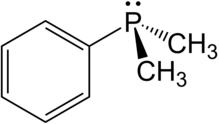Dimethylphenylphosphine

| |||
| |||
| Names | |||
|---|---|---|---|
| Preferred IUPAC name
Dimethyl(phenyl)phosphane | |||
| Other names
Dimethylphenylphosphine
| |||
| Identifiers | |||
3D model (
JSmol ) |
|||
| ChEBI | |||
| ChemSpider | |||
ECHA InfoCard
|
100.010.543 | ||
| EC Number |
| ||
PubChem CID
|
|||
| UNII | |||
CompTox Dashboard (EPA)
|
|||
| |||
| |||
| Properties | |||
| C8H11P | |||
| Molar mass | 138.14 g/mol | ||
| Appearance | transparent light pale yellow liquid | ||
| Density | 0.971 g/cm3 | ||
| Melting point | N/A | ||
| Boiling point | 74 to 75 °C (165 to 167 °F; 347 to 348 K) at 12 mmHg | ||
| Insoluble | |||
| Structure | |||
| Pyramidal | |||
| Hazards | |||
| GHS labelling: | |||
 
| |||
| Warning | |||
| H226, H315, H319, H335 | |||
| P210, P233, P240, P241, P242, P243, P261, P264, P271, P280, P302+P352, P303+P361+P353, P304+P340, P305+P351+P338, P312, P321, P332+P313, P337+P313, P362, P370+P378, P403+P233, P403+P235, P405, P501 | |||
| Flash point | 49 °C (120 °F; 322 K) | ||
| Safety data sheet (SDS) | [1] | ||
Except where otherwise noted, data are given for materials in their standard state (at 25 °C [77 °F], 100 kPa).
| |||
Dimethylphenylphosphine is an
Preparation
Dimethylphenylphosphine is prepared by the reaction of methylmagnesium halide with dichlorophenylphosphine.
- (C6H5)Cl2P + 2CH3MgBr → (C6H5)(CH3)2P + 2MgBrCl
The phosphine is purified by distillation under reduced pressure.[1] A solution of (C6H5)(CH3)2P in CDCl3 shows
Structure and properties
Dimethylphenylphosphine is a
When attached to chiral metal centers, the P-methyl groups are
The νCO of IrCl(CO)(PPh3)2 and IrCl(CO)(PMe2Ph)2 are both at 1960 cm−1, whereas νCO for IrCl(CO)(PMe3)2 is at 1938 cm−1.[4][5]
In terms of basicity, dimethylphenylphosphine is intermediate between that of trialkyl- and triphenylphosphine:[6][7]
- [HPEt3]+ = 8.7
- [HPMe2Ph]+ = 6.8
- [HPPh3]+ = 2.7
The ligand
Where θi represent the half angle.
The resulting angles for PMe3, PMe2Ph, PPh3 are: PMe3 = 118°, PMe2Ph = 122°, PPh3 = 145°. Thus, PMe2Ph is intermediate in size relative to PMe3 and PPh3.[8]
References
- ISBN 9780470132531.
- .
- ISBN 978-0-7514-0413-5
- .
- .
- PMID 17245785..



